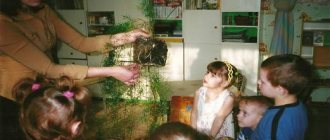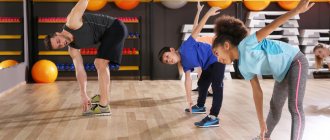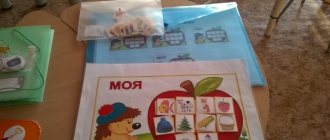The main content of the answer. 1. Goals and objectives of speech development of preschool children in preschool educational institutions
1. Goals and objectives of speech development of preschool children in preschool educational institutions.
The main goal of work on speech development and teaching children their native language is to develop preschoolers’ oral speech and verbal communication skills with others based on mastering the literary language of their people.
Tasks of speech development of preschool children:
- education of sound culture of speech,
- enrichment, consolidation and activation of vocabulary,
-improving grammatical correctness of speech,
-development of coherent speech,
— nurturing interest in artistic expression in preschoolers.
2. Didactic principles of speech development of preschool children.
System of didactic principles for the development of speech in preschool children:
— the principle of the formation of a child’s speech activity as an active process of exchange of cognitive and personal-emotional information (speaking and understanding speech are two types of the same speech activity);
- the principle of interconnection of all aspects of language development: phonetic, lexical and grammatical (the unity of all aspects of language is manifested in its communicative function, which is the main means of language, its essence);
- the principle of speech action (the child is conveyed the idea that not every utterance of sounds, even systems of sounds, is speech. They become speech actions if a number of conditions are met: the speaker has an internal personal motive (why this needs to be said); the presence of a goal ( why this needs to be said); the presence of a thought (what content needs to be conveyed to the interlocutor or listener).
3. Means of speech development for preschool children.
The main means is the speech (language) environment of the preschool educational institution. Requirements for the teacher’s speech as a language model, a speech standard (the level of his culture, literacy, cleanliness, etc.), the main subject of verbal communication with a child in a preschool educational institution.
Effective means of speech development are:
- varied, meaningful activities in preschool educational institutions that activate children’s speech as a means of their communication and self-expression;
- fiction (being an example of literary language and correctness of speech, and at the same time a bright and interesting phenomenon for a child, it is an important means in nurturing the culture of speech, the formation of its coherence and imagery);
- diverse play activities (being the leading type of activity for a preschooler, it stimulates the child to make a variety of speech statements in accordance with the role, plot and rules);
- works of art and artistic means (music, singing, drawing, theatrical performances) provide the child with the opportunity for vivid emotional and aesthetic experiences, entailing the need to convey them to interlocutors and representing the child’s opportunity for self-expression and self-realization;
— visual aids (didactic material) on speech development (they arouse natural interest in children, the work of thought and speech activity).
4. System of methods for speech development of a preschool child.
Methods of speech development of preschool children in preschool educational institutions:
- simulation methods,
- problematic methods,
- search methods,
- communication methods,
- analysis of children's statements.
When answering points 3 and 4 of the plan, it is necessary to substantiate the selection of methods and means of speech development depending on the age of the children, the content and forms and stages of work on speech development.
When covering this examination question, it is necessary to navigate the following concepts: speech, speech development, means of speech development, methods of speech development.
When answering an exam question, it is advisable to give examples from personal professional experience (when opening points 3 and 4).
Report on the topic: “Main tasks of speech development with increasing complexity by age”
Municipal budgetary preschool educational institution "Kindergarten of general developmental type No. 16" "Victoria" Chistopol Municipal District
Report on the topic:
“The main tasks of speech development with increasing complexity by age”
Teachers prepared:
Vorushilo Natalia Sergeevna
Shichkina Lyubov Alexandrovna
Performance date: January 30, 2013
Kindergarten is the first link in the public education system. To become highly educated, a person must master all the riches of his native language. Therefore, one of the most important tasks of a kindergarten is the formation of correct oral speech of children based on their mastery of the literary language of their people. The development of speech must be closely linked with the development of the child’s thinking. Mastering a language and its grammatical structure gives children the opportunity to freely reason, ask questions, draw conclusions, and reflect various connections between objects and phenomena.
Therefore, we can distinguish six particular tasks corresponding to the main components of language and speech that a kindergarten sets for itself for the development of speech in children: vocabulary development, the formation of the grammatical side of speech, the education of the sound culture of speech, the formation of coherent (dialogical and monological) speech, the preparation of children to literacy learning.
- FORMATION OF A DICTIONARY
During preschool childhood, words are learned from the main vocabulary of the language; their selection depends on the vocabulary of those around them, on the child’s orientation in the world around him, etc. Therefore, in kindergarten there is a vocabulary work program that orients the teacher to select, first of all, the vocabulary that is necessary for the child’s normal communication with others and which he spontaneously acquires slowly, with difficulty, with errors. The following tasks are distinguished with increasing difficulty by age:
1 JUNIOR GROUP
Develop understanding of speech and activate vocabulary.
To develop children’s ability, following the teacher’s verbal instructions, to find objects by name, color, size, name their location, imitate the actions of people and the movements of animals.
Enrich children's vocabulary:
•nouns denoting the names of toys, personal hygiene items, clothing, shoes, dishes, furniture, bedding, vehicles, vegetables, fruits, pets and their babies;
- verbs denoting labor actions that are opposite in meaning, actions that characterize the relationships between people and their emotional state;
- adjectives denoting the color, size, taste, temperature of objects using adverbs (close, far, high, fast, quiet, cold, hot, slippery).
Promote the use of learned words in independent speech. By the end of the year, preschoolers should have a vocabulary of at least 1000-1200 words.
2 JUNIOR GROUP
Continue to expand and activate children's vocabulary.
Clarify the names and purposes of items of clothing, shoes, hats, dishes, furniture, and types of transport.
Develop the ability to distinguish and name essential details and parts of objects, qualities, surface features, some materials and their properties (paper easily tears and gets wet), location (high, far, under the cabinet).
Draw children's attention to some objects that are similar in purpose (plate - saucer, fur coat - coat - sheepskin coat).
Develop the ability to understand general words (clothing, furniture, vegetables, etc.); name the parts of the day; name domestic animals and their babies, vegetables and fruits.
MIDDLE GROUP
Replenish and activate vocabulary based on deepening children's knowledge of their immediate environment.
Expand ideas about objects, phenomena, events that did not take place in preschoolers’ own experience.
Intensify the use in speech of the names of objects, their parts, materials from which they are made.
Develop the ability to use adjectives, verbs, adverbs, and prepositions in speech.
Enter nouns denoting professions into the dictionary; verbs characterizing labor actions.
Improve the ability to determine and name the location of an object, time of day.
Use antonym words (clean - dirty, light - dark).
Learn to use nouns with a general meaning (furniture, vegetables, animals, etc.).
SENIOR GROUP
Enrich children's speech with nouns denoting objects in their everyday environment; adjectives characterizing the properties and qualities of objects; adverbs denoting relationships between people, their attitude to work.
Practice selecting nouns for the adjective (white - snow), words with a similar meaning (naughty - mischievous - prankster), with the opposite meaning (weak - strong, cloudy - sunny).
Help children use words exactly as they mean.
SCHOOL PREPARATION GROUP
Continue work to enrich everyday, natural history, and social science vocabulary.
Encourage children to be interested in the meaning of words.
Improve the ability to use different parts of speech in strict accordance with their meaning and purpose of the statement.
Help children master expressive language.
2) SOUND CULTURE OF SPEECH
Work on the sound side of speech is based on data from Russian phonetics and orthoepy. The child, by imitating and learning, purposefully masters the system of stress in words, the intonation structure of his native language, and the pronunciation of words. The following tasks are distinguished with increasing difficulty by age:
1 JUNIOR GROUP
To train children in the clear pronunciation of isolated vowels and consonants (except for whistling, hissing and sonorant sounds), in the correct reproduction of onomatopoeia, words and simple phrases (of 2-4 words),
Promote the development of the articulatory and vocal apparatus, veche breathing, auditory attention.
To develop the ability to use (by imitation) the height and strength of the voice.
2 JUNIOR GROUP
To improve children’s ability to clearly pronounce vowels in words (a, u, i, o ,
e)
and some consonant sounds
(p - 6 - t - d - k - g; f - v; t - s - z - c).
Develop motor skills of the speech-motor apparatus, auditory perception, speech hearing and speech breathing, clarify and consolidate the articulation of sounds.
Develop the correct speech rate and intonation expressiveness. Develop the ability to clearly pronounce words and short phrases, speak calmly, with natural intonations.
MIDDLE GROUP
Reinforce the correct pronunciation of vowels and consonants, practice the pronunciation of whistling, hissing and sonorant sounds (r, l)
sounds.
Develop the articulatory apparatus.
Continue to work on diction: improve the clear pronunciation of words and phrases.
Develop phonemic awareness: learn to distinguish by ear and name words that begin with a certain sound.
Improve intonation expressiveness of speech.
SENIOR GROUP
Strengthen the correct, distinct pronunciation of sounds.
Learn to distinguish by ear and clearly pronounce consonant sounds similar in articulation and sound: s-z, s-ts, sh-zh, ch-ts,
s -
w, g - h, l
-
r.
Continue to develop phonemic awareness. Learn to determine the place of a sound in a word (beginning, middle, end).
Practice intonation expressiveness of speech.
PREPARATORY SCHOOL GROUP
Improve the ability to distinguish by ear and pronunciation all the sounds of the native language.
Practice diction: develop the ability to clearly and distinctly pronounce words and phrases with natural intonations.
Improve phonemic awareness: learn to name words with a certain sound, find words with this sound in a sentence, determine the place of the sound in a word.
Practice intonation expressiveness of speech.
- GRAMMATICAL STRUCTURE OF SPEECH
A dictionary is the building block of language. Grammar establishes the rules for changing words and how to combine them in a sentence. In addition, it defines constructive models of language. The child hears grammatically formatted speech from others. By comprehending what he hears, he assimilates the grammatical structure and learns the models of the language. The following tasks are distinguished with increasing difficulty by age:
1 JUNIOR GROUP
Improve the grammatical structure of speech.
Learn to coordinate nouns and pronouns with verbs, use verbs in the future and past tense, change them by person, use prepositions in speech (in, on, at, for, under).
Practice using some question words (who, what, where) and simple phrases consisting of 2-4 words (“Little kitten, where did you go?”).
2 JUNIOR GROUP
Improve the ability to coordinate adjectives with nouns in gender, number, case;
use nouns with prepositions (in, on, under, for, about).
Help to use in speech nouns in singular and plural form, denoting animals and their young (duck - duckling - ducklings); plural form of nouns in the genitive case. Treat children's word creation as a stage of active mastery of grammar, prompt them to the correct form of the word.
Help children obtain common ones from common simple sentences (consisting only of a subject and predicate) by introducing definitions, additions, and circumstances into them; make sentences with homogeneous members (“We will go to the zoo and see an elephant, a zebra and tigers”).
MIDDLE GROUP
Develop the ability to coordinate words in a sentence, correctly use prepositions in speech; form the plural form of flattering words denoting young animals (by analogy), use these nouns in the nominative and accusative cases (fox cubs - fox cubs, bear cubs - bear cubs);
correctly use the plural form of the genitive case of nouns (forks, shoes).
Recall the correct forms of the imperative mood of some verbs and indeclinable nouns (coat, piano, coffee, cocoa).
Encourage the word creation characteristic of children of the fifth year of life, tactfully suggest a generally accepted word pattern,
Encourage active use in speech of the simplest types of compound and complex sentences.
SENIOR GROUP
Improve the ability to coordinate words in sentences: nouns with numerals (three guys) and adjectives with nouns (frog - green belly).
Help children notice incorrect stress placement in a word, an error in the alternation of consonants, and provide the opportunity to correct it themselves.
Introduce different ways of forming words (sugar bowl, bread bowl).
Exercise in the formation of cognate words (bear - bear - bear cub - bear), including verbs with prefixes (ran - ran out)
Help children correctly use plural nouns in the nominative and accusative cases; verbs in the imperative mood; adjectives and adverbs in comparative degree; indeclinable nouns.
Develop the ability to compose simple and complex sentences based on a model. Improve the ability to use direct and indirect speech.
PREPARATORY SCHOOL GROUP
Continue to practice children in matching words in a sentence.
Improve the ability to form (following a model) words of the same root, nouns with suffixes, verbs with prefixes, comparative and superlative adjectives.
Help to correctly construct complex sentences, use linguistic means to connect their parts (so that, when, , whywhat, if, if, etc.).
4 – 5) CONNECTED SPEECH (dialogic and monologue speech)
Mastering coherent speech is very important for preparing children for school. Coherent speech contributes to the formation of thinking and its various qualities. In addition, the story allows you to reveal the child’s vocabulary, ability to construct phrases, and compositionally design the content. The following tasks are distinguished with increasing difficulty by age:
1 JUNIOR GROUP
Help children answer simple questions (“what?”, “who?”, “what is he doing?”) and more complex questions (“what is he wearing?”, “who?”, “which?”, “where?”, "When?").
Encourage attempts by children over 2 years 6 months, on their own initiative or at the request of the teacher, to talk about what is shown in the picture, about a new toy (new thing), or about an event from personal experience.
During dramatization games, teach children to repeat simple phrases. Help children dramatize passages from familiar fairy tales.
Develop the ability to listen to short stories without visual accompaniment.
2 JUNIOR GROUP
Develop a dialogical form of speech.
Involve children in conversation while looking at objects, paintings, illustrations; observations of living objects; after watching performances and cartoons.
Develop the ability to conduct a dialogue with the teacher: listen and understand the question asked, answer it clearly, speak at a normal pace, v interrupting the adult speaking.
Remind children of the need to say “thank you”, “hello”, “goodbye”, “good night” (in the family, group).
To develop children’s proactive speech in interactions with adults and other children.
MIDDLE GROUP
Improve dialogical speech: learn to participate in a conversation, answer and ask questions in a clear way for listeners.
Develop children's ability to tell stories: describe an object, a picture; practice composing stories based on a picture created by a child using didactic handouts.
Strengthen the ability to retell the most expressive and dynamic passages from fairy tales.
SENIOR GROUP
Develop conversation skills
Improve the dialogical form of speech. Encourage attempts to evoke your point of view, agreement or disagreement with a friend’s answer.
Develop a monologue form of speech.
To develop the ability to coherently, consistently and expressively retell short tales and stories.
To develop the ability (according to a plan and model) to talk about the subject, the content of the plot picture, to compose a story based on pictures with sequentially developing action.
Develop the ability to compose stories about events from personal experience, think of your own endings to fairy tales.
To develop the ability to compose short stories of a creative nature on a topic proposed by the teacher.
PREPARATORY SCHOOL GROUP
Continue to improve dialogic and monologue forms of speech.
Develop the ability to conduct a dialogue with a teacher and a peer; be a friendly and correct interlocutor. Foster a culture of verbal communication.
Develop the ability to meaningfully and expressively retell literary texts and dramatize them.
Improve the ability to compose stories about objects, about the content of a picture, based on a set of pictures with a sequentially developing action. Help create a story plan and stick to it.
Develop the ability to write stories from personal experience.
Continue to improve the ability to write short tales on a given topic.
6) PREPARATION FOR LITERACY TEACHING
PREPARATORY SCHOOL GROUP
All pedagogical work on the development of a child’s speech in kindergarten prepares him for school.
Give an idea of the sentence (without grammatical definition).
Practice composing sentences, dividing simple sentences (without conjunctions or prepositions) into words, indicating their sequence.
To develop the ability to divide two-syllable and three-syllable words with open syllables (na-sha Ma-sha, ma-li-na, be-re-za) into parts.
Learn to form words from syllables (orally).
Learn to identify the sequence of sounds in simple words.
So, we identify 6 main tasks for children’s speech development. Most tasks are solved in all age groups of kindergarten, only their specific content is different: it depends on the age capabilities of the children. Each task has both an educational and educational side. The solution to each of the problems cannot be carried out in isolation.
The content of each task has its own specifics and requires a thoughtful selection of the most appropriate teaching methods and techniques. Knowing what task is the main one in a given speech development lesson, the teacher will purposefully influence the children’s speech, focusing their attention on a certain quality of speech.
Thus, knowledge of the main tasks of speech development is not a formal requirement; it is necessary for the proper organization of work in kindergarten.






